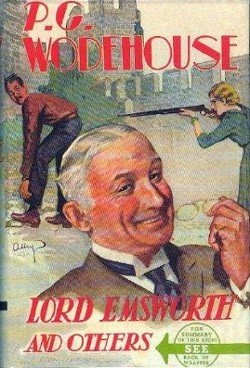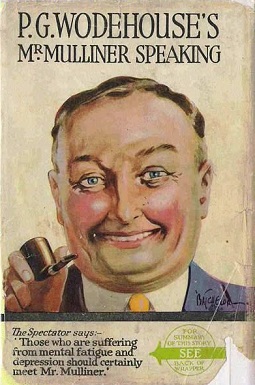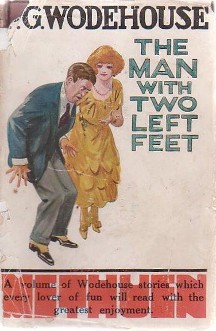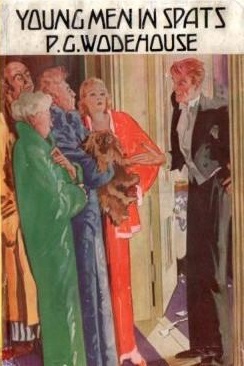Contents
"A Slice of Life"
- UK: Strand, August 1926
- US: Liberty, 7 August 1926
See "A Slice of Life".
"The Bishop's Move"
- US: Liberty, 20 August 1927
- UK: Strand, September 1927
See "The Bishop's Move".
"Came the Dawn"
- US: Liberty, 11 June 1927
- UK: Strand, July 1927
- Plot
A man at the Angler's Rest recounts how his dog won a prize after being mistakenly entered in a local cat show, and notes how mistakes can lead to unexpected good results. Mulliner is inspired to tell the following story, which he claims also shows that you can never tell what will happen in the end and that it is always darkest before the dawn.
Mr Mulliner's nephew Lancelot Bassington Mulliner wants to be a poet, though Lancelot's maternal uncle Jeremiah Biggs, the proprietor of Briggs' Breakfast Pickles, wants him to work in the pickle business. Lancelot falls in love with Angela, the beautiful daughter of the Earl of Biddlecombe, who has little money. While they are dancing, Lancelot says he wants to marry her. Angela admires Lancelot's excellent dancing, but her father wants her to marry someone wealthy, so she is thinking of marrying Slingsby Purvis, of Purvis's Liquid Dinner Glue. Hooping to get a job from his uncle, Lancelot writes a poem praising Briggs's pickles for advertising. Lancelot goes to his uncle's Putney house and reads his poem to his uncle. The poem, titled "Darkling (A Threnody)", is extremely somber, and Briggs has his butler throw Lancelot out.
Lancelot goes to Lord Biddlecombe's residence in Berkeley Square, and asks for Biddlecombe's consent to marry her daughter. Biddlecombe sells some things to Lancelot to make some money, then has his butler throw Lancelot out. A stout man with horn-rimmed spectacles tries to talk to Lancelot, but Lancelot ignores him. Having been unsuccessful with Biggs and Biddlecombe, Lancelot heads to Angela's club, the Junior Lipstick Club (also mentioned in "The Reverent Wooing of Archibald"), in order to plead with Angela to marry him even though he is not rich. She is unwilling to marry a poor poet and says she will marry Purvis. She tells the club's hall-porter to throw Lancelot out. Lancelot is dejected, but the stout man with horn-rimmed spectacles from before appears again and knows all about Lancelot's situation because he has read everything in Lancelot's expressive face. The man, Isadore Zinzinheimer, represents a motion picture company in Hollywood and wants to hire Lancelot as an actor since he registers emotion so well. Lancelot no longer loves Angela and happily agrees to go to Hollywood.
"The Story of William"
- US: Liberty, 9 April 1927 (as "It Was Only a Fire")
- UK: Strand, May 1927
- Plot
An American gentleman visits the Angler's Rest. He speaks highly of California, where he is from. Mr Mulliner remarks that California is fine except for the earthquakes. The American asserts that California is perfect and free of earthquakes. Mr Mulliner argues the contrary, and says that his uncle, William Mulliner, experienced the 1906 San Francisco earthquake. He tells the following story about his uncle's experience, despite the American insisting that what happened in 1906 was only a fire.
William Mulliner loves Myrtle Banks, but she is impressed with the bravery of William's rival, Desmond Franklyn, who claims to have killed sharks and lions. She and Franklyn get engaged. William tries to argue that Franklyn is cruel to animals, but Myrtle is not swayed. William is disappointed, and a hall-porter at the hotel he is staying at suggests he get a drink at a local establishment called Mike's Place. William, until now a teetotaler, follows the hall-porter's advice. He ends up drinking too much and gets thrown out after starting a fight. He falls asleep outside a boarding house for theatrical performers. When he wakes up, he looks inside and sees some unusually small men eating a meal. William, unaware that these men belong to a performing group called Murphy's Midgets, believes he is hallucinating due to the alcohol.
Back at his hotel, William goes to bed. He sees a part of the ceiling fall and hears shouts and crashes, but assumes he is still hallucinating. He falls asleep, and when he wakes up, he sees that the room has in fact largely fallen apart. Myrtle, who was staying at the same hotel, notices William from the exposed hallway and is surprised that he is still in bed. He tells her he noticed the walls falling at night and went to sleep anyway. She calls him the bravest man in the world. She already ended her engagement to Franklyn, who hastily fled when the earthquake started without stopping to help Myrtle. William and Myrtle get married, and name their first son John San Francisco Earthquake Mulliner.
"Portrait of a Disciplinarian"
- US: Liberty, 24 September 1927
- UK: Strand, October 1927
- Plot
Mr Mulliner, just returned from visiting his old nanny, remarks that a nanny will always view a boy she looked after as a boy even after he becomes an adult. He tells the following story about his nephew, Frederick Mulliner.
Frederick Mulliner's brother, Dr George Mulliner, wants Frederick to visit their old nanny, 85-year-old Nurse Wilks. Frederick is reluctant, remembering how she once shut him up in a cupboard for stealing jam. George remarks that she is still inclined to be autocratic. However, her heart is weak. For the sake of her health, Frederick must agree to do whatever she wants him to, including eat boiled eggs, though Frederick tries to protest. She has already been visited by George and the Oliphants, who were also looked after by Nurse Wilks as children. Frederick was recently engaged to Jane Oliphant but she ended the engagement without explanation and got engaged to a man named Dillingwater. Frederick arrives at Nurse Wilks's house in Bingley-on-Sea. She initially seems frail, but soon orders Frederick to take off his boots and makes him feel like a small child.
To Frederick's surprise, Jane Oliphant is at the house. Frederick and Jane argue with each other. Nurse Wilks tells Frederick to apologize to Jane and give her a kiss. He apologizes though he refuses to kiss her. Nurse Wilks orders him to go into the cupboard and stay there until he is good. Frederick hesitates, but he remembers George's warning about Nurse Wilks's heart, so he obeys and goes into the cupboard. Shortly afterward, Jane is sent into the same cupboard for smoking a cigarette. After they argue more, Jane reveals that she ended their engagement because she knew Frederick lied to her about having lunch with another woman. Frederick explains that he was buying the woman's Pekingese dog, which Jane had adored, as a surprise gift for Jane. He still has the dog, which is now in his flat. Jane is delighted. She already broke up with Dillingwater, since she did not love him and only got engaged to him to score off Frederick. They happily embrace. From outside the cupboard, Nurse Wilks asks if Frederick will be good now and kiss Jane. Frederick replies that he will do so, and also bravely faces Nurse Wilks's boiled eggs.
"The Romance of a Bulb-Squeezer"
- UK: Strand, March 1927
- US: Liberty, 12 March 1927
- Plot
Mr Mulliner is inspired by a photograph in an illustrated weekly paper to tell the following tale about his cousin Clarence.
The mayor of Tooting East, Jno. Horatio Biggs, O.B.E., wants aspiring photographer Clarence Mulliner to take his photograph. However, the mayor is ugly and Clarence refuses to take his picture. Clarence makes Biggs leave his studio by prodding him with a tripod, for which Biggs sues him. Clarence's lawyer successfully defends him in court and the jury decides in Clarence's favour. The publicity of the trial makes Clarence a famous and fashionable photographer. Mr Mulliner hears of Clarence's success and visits his studio, but finds Clarence listless and moody. Many beautiful women have had him take their picture and he is now tired of seeing beautiful women. In a traffic jam at the top of Whitehall, Clarence sees a girl in another cab. She does not have a conventionally attractive face. Clarence falls in love with her on sight, but soon the traffic jam clears and she disappears. Clarence is upset about losing her, which makes him seem like a more solemn, profound photographer and enhances his prestige further. The doors of Society open to anyone photographed by him. However, Clarence does not care about his fame and only wants to see the girl in the cab again.
One night, he is visited by a man with a black mask who claims to be a British agent and asks Clarence to come with him to take a photograph of an important visiting dignitary. Clarence follows him but is kidnapped and tied up. The man in the mask was actually the secretary of Biggs, the Mayor of Tooting East, who had Clarence kidnapped. He has given up on having his own photograph taken by Clarence, but insists that Clarence take his daughter's photograph. Clarence breaks free and is also helped by Biggs's daughter, Gladys, who disapproves of her father kidnapping Clarence. Clarence is stunned to see that she is the girl from the cab. She had also seen Clarence in his cab and loves him. Clarence declares that he will take a photograph of her and her father, which makes the mayor sob with joy. Clarence happily retires from commercial photography. Clarence and Gladys's wedding is attended by many important people and they walk out of church under an arch of crossed tripods.
Publication history
All the stories, except "Honeysuckle Cottage", were illustrated by Charles Crombie in the Strand, [2] and by Wallace Morgan in Liberty. [3]
Wodehouse dedicated the book "To the Earl of Oxford and Asquith" (H. H. Asquith). [1]
"The Truth about George", "A Slice of Life", and "Mulliner's Buck-U-Uppo" were included in the 1932 collection Nothing But Wodehouse, edited by Ogden Nash and published in New York by Doubleday, Doran & Company. [4] The same three stories were also included in The Most of P. G. Wodehouse, published in October 1960 by Simon and Schuster, New York. [5]
All of the stories were included in the Mulliner Omnibus, published in October 1935 by Herbert Jenkins Limited. They were also included in The World of Mr. Mulliner, published by Barrie & Jenkins in June 1972 and issued in the US in 1974 by the Taplinger Publishing Company. [6]
"The Romance of a Bulb-Squeezer" was included in the 1981 collection Wodehouse On Crime, edited by D. R. Bensen and published by Ticknor & Fields, New York. [7] It was printed in the Northwest Airlines magazine Northwest in February 1988. [8]

Lord Emsworth and Others is a collection of nine short stories by P. G. Wodehouse, first published in the United Kingdom on 19 March 1937 by Herbert Jenkins, London; it was not published in the United States. The Crime Wave at Blandings, which was published on 25 June 1937 by Doubleday, Doran, New York, is a very different collection, sharing only three of its seven titles with the UK book. Penguin Books published a UK edition of The Crime Wave at Blandings in 1966. The stories in both books had all previously appeared in both British and American magazines.
Mr. Mulliner is a fictional character from the short stories of P. G. Wodehouse. Mr. Mulliner is a loquacious pub raconteur who, no matter what the topic of conversation, can find an appropriate story about a member of his family to match it.

Plum Pie is a collection of nine short stories by P. G. Wodehouse, first published in the United Kingdom on 22 September 1966 by Barrie & Jenkins, and in the United States on 1 December 1967 by Simon & Schuster, Inc., New York. The collection's title is derived from P. G. Wodehouse's nickname, Plum.

Blandings Castle and Elsewhere is a collection of short stories by P. G. Wodehouse. It was first published in the United Kingdom on 12 April 1935 by Herbert Jenkins, London, and, as Blandings Castle, in the United States on 20 September 1935 by Doubleday Doran, New York. All the stories had previously appeared in Strand Magazine (UK) and all except the last in various US magazines.

A Few Quick Ones is a collection of ten short stories by P. G. Wodehouse. It was first published in the United States on 13 April 1959 by Simon & Schuster, New York, and in the United Kingdom on 26 June 1959 by Herbert Jenkins, London. The first US edition dust jacket was designed by Paul Bacon. The book's title comes from the informal phrase "a quick one", which is British slang for an alcoholic drink consumed quickly.

Eggs, Beans and Crumpets is a collection of short stories by P. G. Wodehouse, first published in the United Kingdom on April 26, 1940 by Herbert Jenkins, London, then with a slightly different content in the United States on May 10, 1940 by Doubleday, Doran, New York.

Mr Mulliner Speaking is a collection of nine short stories by P. G. Wodehouse. It was first published in the United Kingdom on April 30, 1929 by Herbert Jenkins, and in the United States on February 21, 1930 by Doubleday, Doran. The stories were originally published in magazines in the UK and the US between 1924 and 1929.

The Man with Two Left Feet, and Other Stories is a collection of short stories by British author P. G. Wodehouse, first published in the UK on 8 March 1917 by Methuen & Co., London, and in the US on 1 February 1933 by A. L. Burt and Co., New York. All the stories had previously appeared in periodicals, usually The Strand Magazine in the United Kingdom and The Red Book Magazine or The Saturday Evening Post in the United States.

The Small Bachelor is a novel by P. G. Wodehouse, first published in the United Kingdom on 28 April 1927 by Methuen & Co., London, and in the United States on 17 June 1927 by George H. Doran, New York.

Mulliner Nights is a collection of short stories by P. G. Wodehouse. First published in the United Kingdom on 17 January 1933 by Herbert Jenkins, and in the United States on 15 February 1933 by Doubleday, Doran. The stories in the collection were originally published in magazines in the UK and the US between 1930 and 1932.

Young Men in Spats is a collection of short stories by P. G. Wodehouse, first published in the United Kingdom on 3 April 1936 by Herbert Jenkins, London, then in the United States with a slightly different selection of stories on 24 July 1936 by Doubleday, Doran, New York.
"Lord Emsworth Acts for the Best" is a short story by P. G. Wodehouse, which first appeared in the United Kingdom in the June 1926 Strand Magazine, and in the United States in the 5 June 1926 issue of Liberty. Part of the Blandings Castle canon, it features the absent-minded peer Lord Emsworth, and was included in the collection Blandings Castle and Elsewhere (1935), although the story takes place sometime between the events of Leave it to Psmith (1923) and Summer Lightning (1929).

Reginald "Reggie" Pepper is a fictional character who appears in seven short stories by English author P. G. Wodehouse. Reggie is a young man-about-town who gets drawn into trouble trying to help his pals. He is considered to be an early prototype for Bertie Wooster, who, along with his valet Jeeves, is one of Wodehouse's most famous creations.
"Mulliner's Buck-U-Uppo" is a short story by the British comic writer P. G. Wodehouse. A part of the Mr. Mulliner series, the story was first published in the United States by Liberty Magazine on September 4, 1926 and in the United Kingdom in The Strand in November 1926. It was collected in Meet Mr. Mulliner (1927).
"Best Seller" is a short story by the British comic writer P. G. Wodehouse. A part of the Mr. Mulliner series, the story was first published in the US in Cosmopolitan in June 1930, and in the UK in The Strand Magazine in July 1930. The Cosmopolitan version of the story does not include Mr Mulliner. The Mulliner version of the story was included in the collection Mulliner Nights (1933).
"A Slice of Life" is a short story by the British comic writer P. G. Wodehouse. A part of the Mr. Mulliner series, the story was first published in the UK in 1926 in The Strand Magazine, and appeared almost simultaneously in Liberty in the United States. It also appears in the collection Meet Mr. Mulliner. The main character in this story, Wilfred Mulliner, plays off-stage parts in "Mulliner's Buck-U-Uppo".
"The Truth About George" is a short story by the British comic writer P. G. Wodehouse. A part of the Mr. Mulliner series, the story was first published in July 1926 in Strand Magazine, and appeared almost simultaneously in Liberty in the United States. It also appears in the collection Meet Mr. Mulliner.
"The Bishop's Move" is a short story by the British comic writer P. G. Wodehouse. A part of the Mr. Mulliner series, the story was first published in August 1927 in Liberty in the United States, and in September 1927 in The Strand Magazine in the UK. It also appears in the collection Meet Mr. Mulliner.
"Honeysuckle Cottage" is a short story by the British author P. G. Wodehouse. The story was first published in the 24 January 1925 issue of the Saturday Evening Post in the United States, and in the February 1925 issue of the Strand Magazine in the United Kingdom.
"George and Alfred" is a short story by P. G. Wodehouse and a Mr. Mulliner story. It was published in Playboy magazine in the US in January 1967. The story was also included in the 1966 collection Plum Pie.











